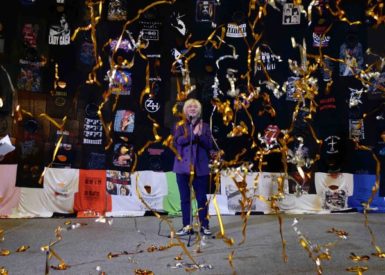ART WORLD NEWS
Aichi Triennale Artists Decry ‘Censorship’ of Exhibition, Saying Public Was ‘Robbed’ of Discussion -ARTnews
[ad_1]
Aichi Triennale artistic director Daisuke Tsuda at the opening ceremony for the exhibition.
ITO TETSUO
After the 2019 edition of the Aichi Triennale in Nagoya, Japan, closed a controversial portion of the exhibition over the weekend, more than 70 artists in the show have issued a statement saying that the triennial and the local government were engaging in “censorship.”
The shuttered portion of the show—titled “After ‘Freedom of Expression?’ ”—deals with the history of art censorship in Japan, and one work, which has been the target of protests, directly deals with the country’s history World War II policies surrounding comfort women, who were raped by military officers. First staged at a gallery in Tokyo in 2015, “Freedom of Expression?” project gathered works that had been censored in Japan, and this iteration updated it with works that had been censored since 2015.
The statement, which was posted to Facebook on Tuesday, is signed by 72 of the more than 90 artists in the exhibition, and it calls for “After ‘Freedom of Expression?’ ” to remain on view. It refers to the exhibition space as “an open, public site” and says that “the closure of the exhibit just three days after the Triennale opening has robbed people of the opportunity to see the artworks and foreclosed any active discussion of them.”
Among the signatories are Candice Breitz, Tania Bruguera, Miriam Cahn, Pia Camil, Chim↑Pom, Regina José Galindo, Claudia Martínez Garay, Minouk Lim, Park Chan-kyong, and Javier Téllez. A representative for the Triennale did not respond to a request for comment.
The closed Triennale portion included a project by Korean artists Kim Seo-kyung and Kim Eun-sung, whose sculptural work, Statue of a Girl of Peace, deals with the country’s history of ianfu, or comfort women. During World War II, Japan maintained brutal colonial policies across Asia as part of its war efforts; one such mandate involved forcing women from across the continent, many from the Korean peninsula, into sexual slavery. Ianfu remain a point of contention in the country’s wartime history, as it was not officially acknowledged by the Japanese government until 2015.
The Triennale opened to the public last Thursday and was immediately met with protests against “After ‘Freedom of Expression?,’ ” including an anonymous fax with a threat to ignite a fire at the show.
With mounting pressure from figures such as Nagoya’s mayor, Takashi Kawamura, who said the “After ‘Freedom of Expression?’ ” exhibition “tramples on the feelings of Japanese citizens,” the 2019 Triennale’s artistic director, journalist Daisuke Tsuda, and the governor of Aichi Prefecture, Hideaki Omura, decided to close the protested portion of the show, citing safety concerns.
While the artists said in their statement that every precaution should be taken to prevent “to resist such terroristic threats and intimidation” and ensure the welfare of staff and visitors, they believe that government intervention to close the exhibition was not the appropriate response. In their letter, the artists demand the continuation of the exhibition with an assurance to safety for visitors and “the establishment of a platform for free and vigorous discussion that is open to all, including the participating artists.”
“We practice art not to suppress or divide people, but to find different ways of creating solidarity among them, and to pursue the possibilities for free thinking beyond political beliefs,” the artists’ statement reads. “We strive to be creative in the face of uncertainty.”
[ad_2]
Source link











